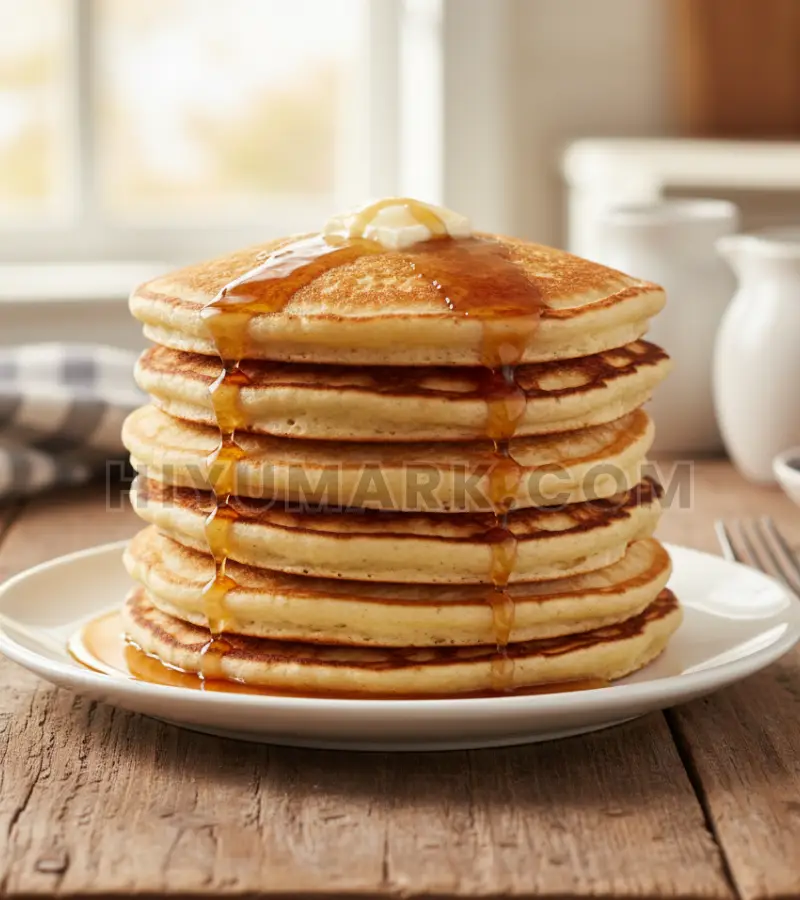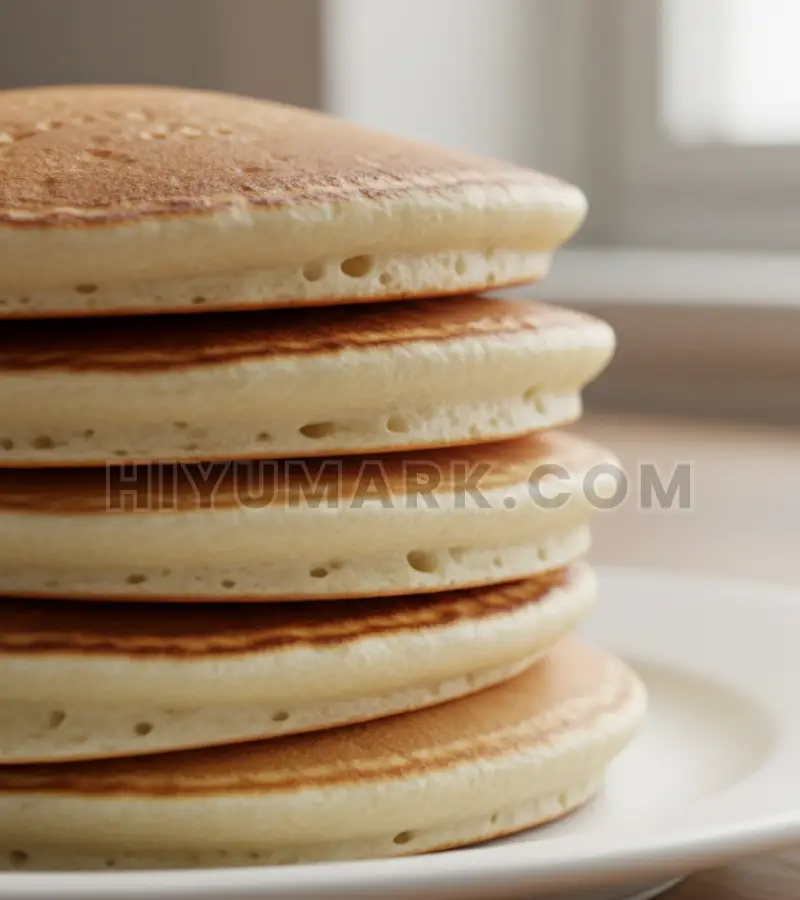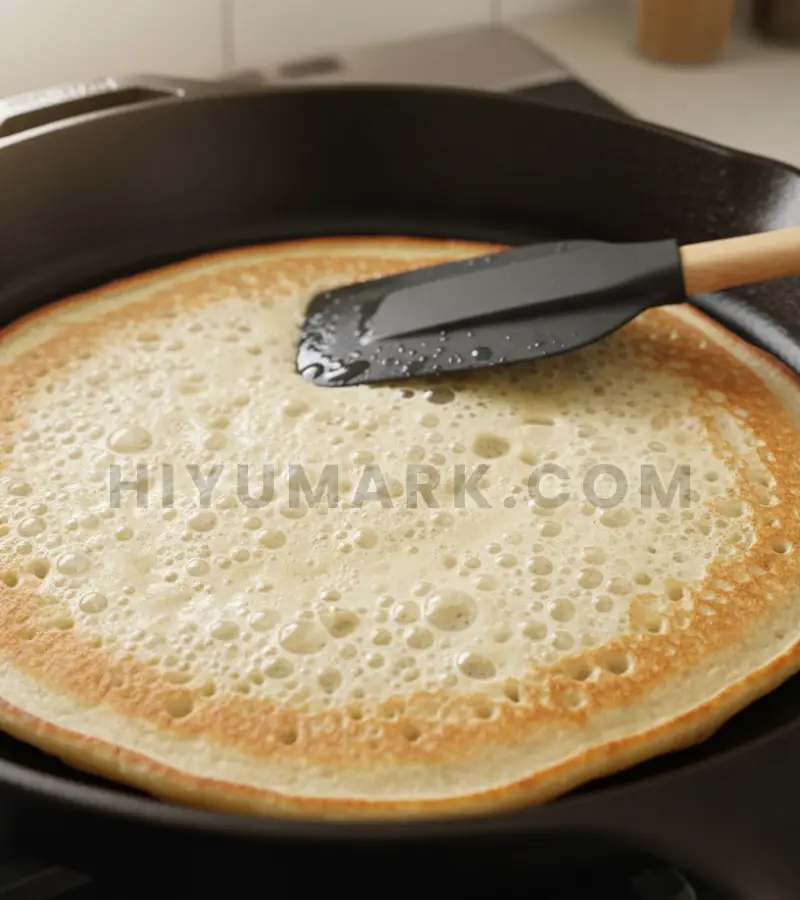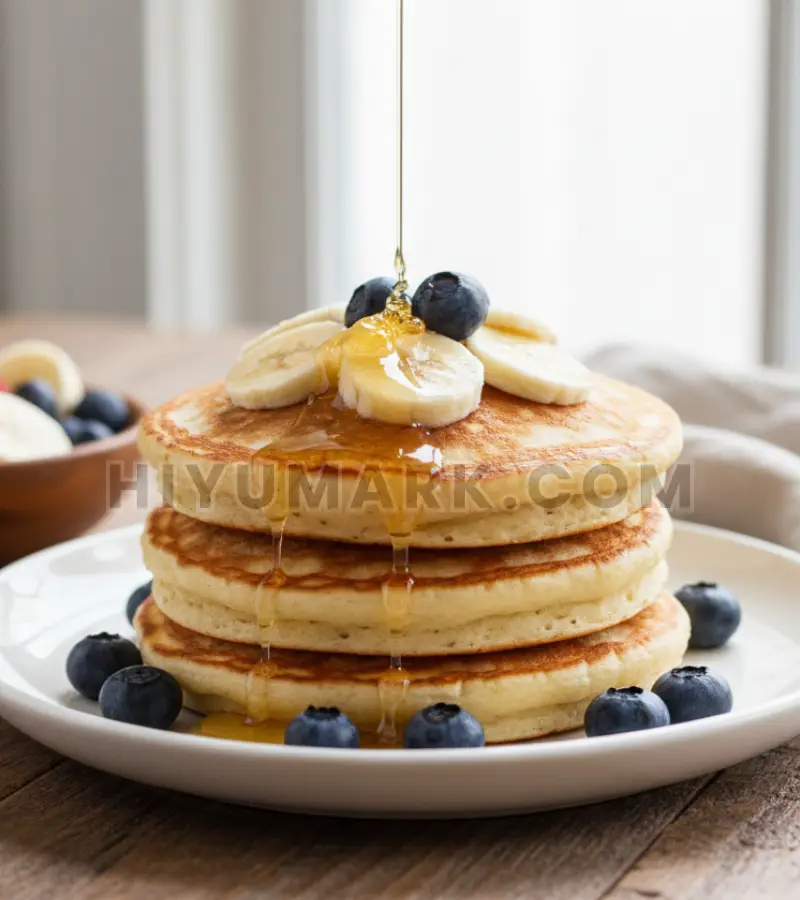Amish pancakes recipe: light, fluffy, and slightly tangy from buttermilk. These farmhouse-style pancakes use simple ingredients yet deliver a breakfast that feels hearty, comforting, and made for sharing.
Some breakfasts are quick; others carry a sense of tradition. Amish pancakes belong in the second group. They’re tender inside, golden on the outside, and made with ingredients every pantry has – flour, eggs, milk, and baking staples.

What makes them stand out is the balance of fluffiness and mild tang. Thanks to buttermilk and the classic Amish approach to cooking, they rise beautifully and hold together without feeling heavy. Each bite is soft, warm, and perfect for maple syrup or homemade jam.
This recipe connects to Amish and Pennsylvania Dutch kitchens, where hearty breakfasts were the start of long days on the farm.
Today, they remain a favorite for family mornings, weekend brunches, or whenever you want pancakes that taste like home.
What Are Amish Pancakes?
Amish pancakes are simple, farmhouse-style pancakes known for their fluffy texture and mild tang from buttermilk.
They look like regular pancakes but have a lighter crumb and a flavor that feels richer and more balanced.
In Amish and Pennsylvania Dutch homes, pancakes are more than a quick breakfast. They’re a centerpiece of family mornings, served with butter, syrup, or homemade fruit preserves.
Many families even make them for church gatherings or after farm chores, where a hearty plate keeps everyone full.

You may also hear them called flannel cakes or griddle cakes, names that reflect their soft texture and the way they’re cooked on a hot skillet.
Some versions are referred to as feather-light pancakes because of how airy they turn out.
Compared to standard diner pancakes, Amish versions use a bit more buttermilk and baking soda, which creates the gentle rise and slight tang.
The result is a pancake that holds syrup beautifully without turning soggy, making every bite satisfying.
Simple Ingredients You’ll Need
Every good Amish pancake recipe relies on simple, affordable ingredients. Each one has a role in making the pancakes fluffy, golden, and full of flavor.
Flour
All-purpose flour is the classic choice. It gives structure while keeping the pancakes tender. Some cooks mix in whole wheat flour for a nuttier flavor.
Buttermilk
This is what sets Amish pancakes apart. Buttermilk reacts with baking soda to create a light rise and adds a mild tang that balances sweetness. If you don’t have buttermilk, regular milk with a splash of vinegar or lemon juice works too.
Eggs
Eggs bind the batter and give it richness. They also help the pancakes puff slightly, keeping them from being flat or rubbery.
Baking Powder and Baking Soda
Both leavening agents are used together. Baking powder provides steady lift, while baking soda reacts with the buttermilk for extra fluff.
Sugar
A small amount of sugar sweetens the batter just enough. It also helps the pancakes brown evenly on the griddle.
Salt
Salt balances the sweetness and sharpens flavor. Without it, the pancakes can taste dull.
Fat (Butter or Oil)
Melted butter adds richness and flavor, while oil keeps the pancakes moist. Many cooks use butter in the batter and oil for cooking.
Optional Extras
Vanilla gives warmth and depth. A pinch of cinnamon adds gentle spice. Blueberries or chocolate chips can be folded in for variety.
Equipment
You’ll need a mixing bowl, whisk, ladle, spatula, and a skillet or griddle. Cast iron or nonstick pans work best for even browning.
How to Make Amish Pancakes? Step by Step Process
Making Amish pancakes is easy, but following the steps carefully ensures they turn out fluffy and golden every time.

Step 1: Mix the Dry Ingredients
In a large bowl, whisk together the flour, sugar, baking powder, baking soda, and salt. Mixing them first spreads the leavening evenly through the batter.
Step 2: Combine the Wet Ingredients
In another bowl, beat the eggs lightly. Add the buttermilk and melted butter, then whisk until smooth. This mixture gives the pancakes their rich, tender texture.
Step 3: Bring It Together
Pour the wet mixture into the dry ingredients. Stir gently until just combined. A few lumps are fine—overmixing will make the pancakes tough.
Step 4: Heat the Griddle
Warm a lightly greased skillet or griddle over medium heat. Test the temperature by sprinkling a few drops of water—if they sizzle, the pan is ready.
Step 5: Cook the Pancakes
Scoop about ¼ cup of batter for each pancake. Cook until bubbles form on the surface and the edges look set, then flip carefully. Cook the other side until golden brown.
Step 6: Keep Warm and Serve
Place cooked pancakes on a plate and cover loosely to keep warm while you finish the batch. Serve with butter, maple syrup, or your favorite toppings.
Tip: Rest the batter for 5–10 minutes before cooking for even fluffier pancakes.
Variations and Easy Swaps
One of the best things about an Amish pancakes’ recipe is how easily it can be adapted. Here are some popular ways families adjust the batter.
Whole Wheat or Healthier Versions
Swap part of the all-purpose flour with whole wheat flour for a heartier taste. Oats can also be blended in for extra texture and nutrition.
Blueberry or Fruit Add-Ins
Fresh or frozen blueberries fold in beautifully. Sliced bananas, apples, or strawberries can also be added for a sweet twist that pairs well with maple syrup.
Chocolate Chip Pancakes
For kids or dessert-style pancakes, fold in chocolate chips. Semi-sweet or dark chocolate works best since it balances the sweetness of the batter.
Gluten-Free Option
Use a gluten-free all-purpose blend in place of regular flour. With buttermilk and eggs, the pancakes stay fluffy even without wheat.
Dairy-Free or Vegan
Replace buttermilk with almond milk mixed with lemon juice or vinegar. Use oil instead of butter, and a flax egg or egg replacer instead of regular eggs.
Amish Flannel Cakes
Some Amish recipes call these flannel cakes—made thinner and lighter than regular pancakes. The batter is often looser, producing pancakes that feel airy and delicate.
Tips for Fluffy Pancakes Every Time
The secret to great Amish pancakes is in the small details. A few adjustments can make the difference between flat pancakes and ones that are fluffy and delicious.
- Don’t Overmix: When combining wet and dry ingredients, stop stirring once the flour is just absorbed. A few lumps are fine—overmixing develops gluten and makes the pancakes tough.
- Let the Batter Rest: Allow the batter to sit for 5–10 minutes before cooking. This gives the leavening time to activate and helps the flour fully hydrate, making the pancakes lighter.
- Control the Heat: A medium heat works best. If the skillet is too hot, the outside browns before the inside cooks. If it’s too cool, the pancakes spread too much and turn pale.
- Flip at the Right Time: Watch for bubbles forming on the surface and edges that look set. That’s the signal to flip. Turning too early or too late affects both texture and color.
- Keep Them Moist and Fluffy: Stack pancakes on a plate and cover loosely with a towel to keep warmth and moisture in. This prevents them from drying out while you finish the batch.
Serving Ideas and Tasty Pairings
Amish pancakes shine brightest when paired with the right toppings and sides. A good serving idea can turn them from a simple breakfast into a memorable meal.

Classic Sweet Style
The traditional way is with butter and maple syrup. The mild tang of the pancake’s balances perfectly with the sweetness of syrup and richness of butter.
Amish-Inspired Toppings
Try spreading homemade fruit preserves, berry compote, or apple butter. These toppings match the farmhouse roots of the recipe and bring natural sweetness.
Fresh Additions
A side of fresh fruit like strawberries, blueberries, or sliced bananas makes the plate colorful and adds freshness to the rich pancakes.
Savory Pairings
Serve pancakes alongside bacon, sausage, or fried eggs for a hearty breakfast plate. The savory flavors balance the sweetness of the syrup beautifully.
Creative Serving Ideas
Stack pancakes tall and layer with whipped cream, nuts, or chocolate drizzle for a brunch centerpiece. You can even use them as a base for breakfast sandwiches.
Make-Ahead, Storing, and Freezing Pancakes
One reason people love an Amish pancakes recipe is that it’s easy to prepare ahead and store for later. That makes it perfect for busy mornings.
Make-Ahead Batter
You can mix the dry ingredients the night before and keep them in a sealed container. In the morning, just add the wet ingredients and cook. If you make full batter ahead, refrigerate overnight and stir gently before using.
Storing Cooked Pancakes
Leftover pancakes keep well in the refrigerator for 3–4 days. Stack them with parchment paper between layers and store in an airtight container.
Freezing Pancakes
For longer storage, freeze pancakes on a baking sheet until firm, then transfer to freezer bags. They stay fresh for up to 2 months and can be reheated straight from frozen.
Reheating Options
Warm leftovers in a toaster for crisp edges, in the microwave for speed, or in the oven at low heat for larger batches. Each method keeps them soft without drying out.
Fixing Common Pancake Problems
Even with a good Amish pancakes recipe, things can go wrong. Here’s how to fix the most common problems.
- Flat Pancakes: If your pancakes don’t rise, the baking powder or baking soda may be old, or the batter may have been overmixed. Always use fresh leavening and stir gently.
- Dense or Heavy Texture: Too much flour or too little liquid makes pancakes dense. Measure ingredients carefully and don’t skip the buttermilk, which keeps them light.
- Over-Browned Outside, Raw Inside: This happens when the heat is too high. Lower the temperature and cook longer so the inside has time to set before the outside gets too dark.
- Batter Too Runny: Batter spreading too thin means it needs a little extra flour. The texture should hold its shape on the griddle but not turn stiff.
- Batter Too Thick: Thick batter makes stodgy pancakes. Add a splash of milk or buttermilk to loosen it until it pours smoothly but not watery.
- Pancakes Sticking to Pan: Sticking usually happens because the pan wasn’t hot or greased enough. Use a nonstick pan or oil lightly, and heat well before adding batter.
Frequently Asked Questions
When it comes to making Amish pancakes, home cooks often face the same questions about ingredients, storage, and technique. Here are clear answers to the most common ones.
Can I use regular milk instead of buttermilk?
Yes. For each cup of buttermilk, use 1 cup of milk mixed with 1 tablespoon of vinegar or lemon juice. Let it sit for 5 minutes before adding.
What makes Amish pancakes different from regular pancakes?
They use buttermilk plus both baking soda and baking powder. This combination gives them extra lift and a mild tang that regular pancakes usually don’t have.
How do I make them extra fluffy?
Don’t overmix the batter, let it rest for a few minutes, and cook on medium heat. Fresh leavening also makes a big difference.
Can I make the batter ahead of time?
It’s best to mix dry ingredients and wet ingredients separately, then combine just before cooking. A fully mixed batter stored overnight may lose some lift.
Can I freeze cooked pancakes?
Yes. Freeze them in a single layer first, then stack in bags or containers. They reheat well in the toaster or oven.
How do I reheat leftovers without drying them out?
Warm them in the toaster for crisp edges or cover with a damp paper towel in the microwave to keep them soft.
Why You’ll Love This Recipe?
This recipe looks simple, yet it carries qualities that make it memorable and worth keeping in your regular breakfast rotation.
Rooted in Tradition
The recipe reflects Amish and Pennsylvania Dutch kitchens, where wholesome breakfasts were built from pantry staples. It keeps that homemade, comforting feel alive.
Fluffy Yet Hearty
Thanks to buttermilk and the right balance of leavening, the pancakes turn out light without losing their ability to fill you up. Each bite feels soft but satisfying.
Flexible for Every Cook
Whether you prefer plain, fruity, or chocolate-studded pancakes, this batter adapts easily. It also works for gluten-free and dairy-free adjustments.
Perfect for Sharing
These pancakes are made for family mornings, weekend brunches, or holiday tables. They cook quickly, reheat well, and serve as a base for both sweet and savory toppings.
Conclusion
A plate of Amish pancakes is more than breakfast – it’s comfort you can taste. Fluffy, golden, and slightly tangy, they turn simple ingredients into something special.
This recipe is flexible enough for every kitchen yet rooted in a tradition that values hearty, homemade food. Whether you serve them with syrup, fruit, or savory sides, these pancakes always deliver warmth and satisfaction. Try them once, and they might become the recipe your family asks for every weekend morning.
Read related recipes:
Amish Pancakes Recipe
Course: BreakfastCuisine: AmericanDifficulty: Easy8
servings10
minutes15
minutes210
kcal25
minutesFluffy Amish pancakes made with buttermilk, flour, eggs, and simple pantry staples. A light, golden breakfast that tastes like comfort.
Ingredients
2 cups all-purpose flour
2 tablespoons sugar
2 teaspoons baking powder
1 teaspoon baking soda
½ teaspoon salt
2 eggs
2 cups buttermilk (or substitute: milk + 2 tbsp vinegar)
4 tablespoons melted butter (plus extra for cooking)
1 teaspoon vanilla extract (optional)
Directions
- In a bowl, whisk together flour, sugar, baking powder, baking soda, and salt.
- In another bowl, beat eggs. Add buttermilk, melted butter, and vanilla. Whisk until smooth.
- Pour wet mixture into dry ingredients. Stir gently until just combined. Do not overmix.
- Heat a lightly greased skillet or griddle over medium heat.
- Pour about ¼ cup batter for each pancake. Cook until bubbles form and edges look set, then flip.
- Cook the other side until golden brown. Repeat with remaining batter.
- Serve warm with butter, syrup, or fruit.
Recipe Video
Notes
- Use fresh baking powder and baking soda for best rise. Don’t overmix the batter-lumps are fine. Let the batter rest 5 minutes before cooking for fluffier pancakes.
